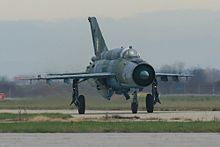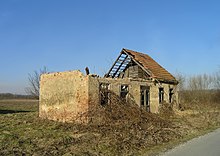Operation Storm
The HV was supported by the Croatian special police advancing from the Velebit Mountain, and the ARBiH located in the Bihać pocket, in the Army of the Republic of Serbian Krajina's (ARSK) rear.
The Croatian population had been years prior subjected to ethnic cleansing in the areas held by ARSK by rebel Serb forces, with an estimated 170,000–250,000 expelled and hundreds killed.
Human rights violations included killings, disappearances, beatings, harassment, forced resettlement, or exile, designed to ensure Serbian dominance of the areas.
[25] Serbia continued to support the RSK,[27] but a series of HV advances restored small areas to Croatian control as the siege of Dubrovnik ended,[28] and Operation Maslenica resulted in minor tactical gains.
[62] In December 1994, Croatia and the RSK made an economic agreement to restore road and rail links, water and gas supplies, and use of a part of the Adria oil pipeline.
On 22 July, Tuđman and Bosnian President Alija Izetbegović signed the Split Agreement for mutual defence, permitting the large-scale deployment of the HV in Bosnia and Herzegovina.
The talks were used by Croatia to prepare diplomatic ground for the imminent Operation Storm,[72] whose planning was completed during the Brijuni Islands meeting between Tuđman and military commanders on 31 July.
[85] The Zagreb Corps was tasked with bypassing Petrinja to neutralize ARSK artillery and missiles potentially targeting Croatian cities, making a secondary thrust from Sunja towards Hrvatska Kostajnica.
[84] In late 1994, the Fikret Abdić-led Autonomous Province of Western Bosnia (APWB)—a sliver of land northwest of Bihać between its ally RSK and the pocket—commanded 4,000–5,000 soldiers who were deployed south of Velika Kladuša against the ARBiH force.
The HV Sinj Operational Group (OG), on the left flank of the two brigades, joined the attack and the 126th Home Guard Regiment captured Uništa, gaining control of the area overlooking the Sinj–Knin road.
[107] In the Ogulin area of the HV Karlovac Corps AOR, the 99th Brigade, reinforced by the 143rd Home Guard Regiment's Saborsko Company, moved towards Plaški at 5 a.m., but the force was stopped and turned back in disarray by 6 p.m.
Both crossings established bridgeheads, although the bulk of the units were forced to retreat as the ARSK counter-attacked—only a battalion of the 153rd Brigade and elements of the 20th Home Guard Regiment held their ground.
The crossings prompted the ARSK General Staff to order the 2nd Armoured Brigade of the Special Units Corps to move from Slunj to the bridgeheads,[109] as the HV advance threatened a vital road in Glina.
[109] In the Bjelovar Corps AOR, two battalions of the 125th Home Guard Regiment crossed the Sava River near Jasenovac, secured a bridgehead for trailing HV units and advanced towards Hrvatska Dubica.
A reconnaissance platoon of the 52nd Home Guard Regiment crossed the Sava River into the Republika Srpska, established a bridgehead for two infantry companies and subsequently demolished the Bosanska Dubica–Gradiška road before returning to Croatian soil.
[125] By capturing Glina, the HV trapped the bulk of the ARSK Kordun Corps and about 35,000 evacuating civilians in the area of Topusko, prompting its commander to request UNCRO protection.
The terms of surrender specified the handover of weapons, except officers' side arms, on the following day, and the evacuation of persons from Topusko via Glina, Sisak, and the Zagreb–Belgrade motorway to Serbia, protected by the Croatian military and civilian police.
[143] Also on 4 August, the RSK 105th Aviation Brigade based at Udbina, deployed helicopters against the Croatian special police on Velebit Mountain and against targets in the Gospić area virtually to no effect.
An additional pair of MiG-21s was deployed to patrol the airspace over Ivanić Grad and intercept two Bosnian Serb fighter jets, but they failed to do so due to fog in the area and their low level of flight.
[152] In eastern Slavonia, the HV Osijek Corps was tasked with preventing ARSK or Yugoslav Army forces from advancing west in the region, and counter-attacking into the ARSK-held area around Vukovar.
[149] The most significant coordinated ARSK effort occurred on 5 August, when the exchange was compounded by three RSK air raids and an infantry and tank assault targeting Nuštar, northeast of Vinkovci.
[154] Operation Storm led the Yugoslav Army to mobilize and deploy considerable artillery, tanks and infantry to the border area near eastern Slavonia, but it took no part in the battle.
The Croatian Navy supported the operation deploying the Korčula, Brač and Hvar Marine Detachments, as well as missile boats, minesweepers, anti-submarine warfare ships and coastal artillery.
The ARSK military was unable to check outflanking manoeuvres and their Special Units Corps failed as a mobile reserve, holding back the HV's 1st Guards Brigade south of Slunj for less than a single day.
[179] Aiming to reduce evidence of political failure, Yugoslav authorities sought to disperse the refugees in various parts of Serbia and prevent their concentration in the capital, Belgrade.
[197] They reported that Croatian Serbs continued to face discrimination in public sector employment and the restitution of tenancy rights to social housing vacated during the war.
[221] They referred to the ICTY testimony of RSK Commander Mile Mrkšić, who stated that on 4 August 1995, sometime after 16:00 hrs, it was Milan Martić and his staff who in fact made a decision to evacuate the Serb population from Krajina to Srb, a village near the Bosnian border.
[242] On the 25th anniversary of the Operation, the Balkan Investigative Reporting Network analyzed documents from the ICTY trial and found that very few of the perpetrators of killings of Serb civilians have been brought to justice while none of the commanders of the units responsible have been prosecuted.
[254] In Serbia, Milošević condemned the Croatian attack, but the Milošević-influenced press also denounced the leadership of the RSK as being incompetent,[255] while the most extreme politicians, including Vojislav Šešelj, demanded retaliation against Croatia.
At the celebration, Prime Minister Plenković, President Zoran Milanović and General Gotovina sent messages of peace and reconciliation and sympathy for Serbian civilian victims as well.



HV , ARSK
In Bosnia and Herzegovina:
HV/ HVO , VRS /ARSK , ARBiH /HVO , APWB









